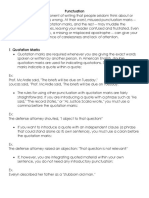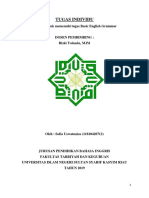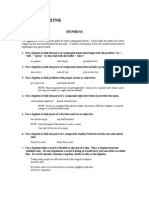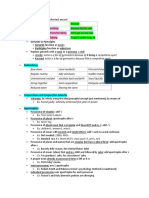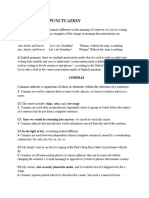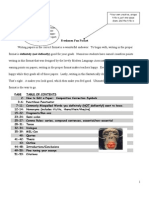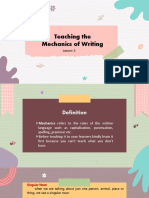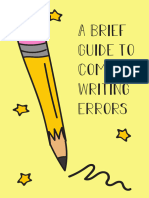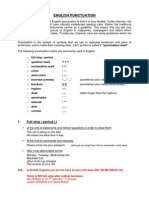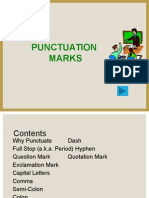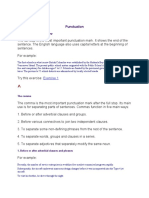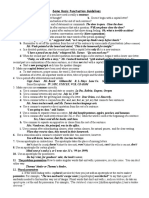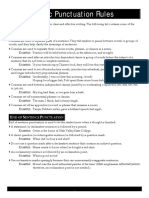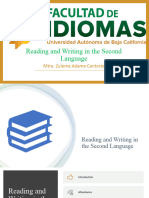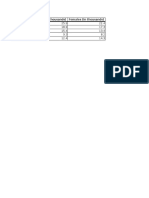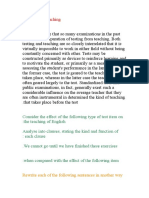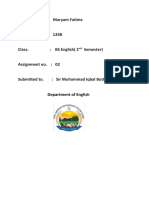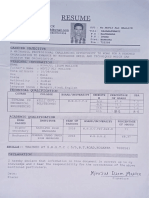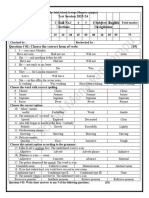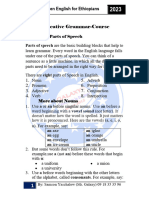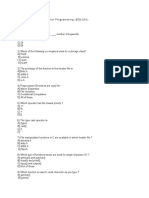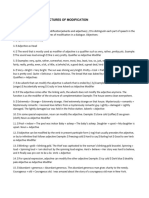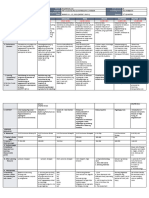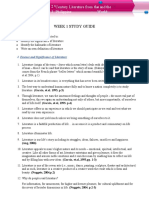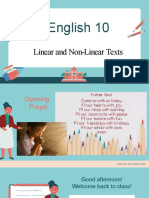The Apostrophe
The apostrophe has three uses:
1) to form possessives of nouns
2) to show the omission of letters
3) to indicate certain plurals of lowercase letters.
Apostrophes are NOT used for possessive pronouns or for noun plurals, including
acronyms.
Forming possessives of nouns
To see if you need to make a possessive, turn the phrase around and make it an "of
the..." phrase. For example:
the boy's hat = the hat of the boy
three days' journey = journey of three days
If the noun after "of" is a building, an object, or a piece of furniture, then no
apostrophe is needed!
room of the hotel = hotel room
door of the car = car door
leg of the table = table leg
Once you've determined whether you need to make a possessive, follow these rules to
create one.
add 's to the singular form of the word (even if it ends in -s):
the owner's car
James's hat
add 's to the plural forms that do not end in -s:
the children's game
the geese's honking
add ' to the end of plural nouns that end in -s:
houses' roofs
three friends' letters
add 's to the end of compound words:
�my brother-in-law's money
add 's to the last noun to show joint possession of an object:
Todd and Anne's apartment
Showing omission of letters
Apostrophes are used in contractions. A contraction is a word (or set of numbers) in
which one or more letters (or numbers) have been omitted. The apostrophe shows this
omission. Contractions are common in speaking and in informal writing. To use an
apostrophe to create a contraction, place an apostrophe where the omitted letter(s)
would go. Here are some examples:
don't = do not
I'm = I am
he'll = he will
who's = who is
shouldn't = should not
didn't = did not
could've = could have (NOT "could of"!)
'60 = 1960
Forming plurals of lowercase letters
Apostrophes are used to form plurals of letters that appear in lowercase; here the rule
appears to be more typographical than grammatical, e.g. "three ps" versus "three p's."
To form the plural of a lowercase letter, place 's after the letter. There is no need for
apostrophes indicating a plural on capitalized letters, numbers, and symbols (though
keep in mind that some editors, teachers, and professors still prefer them). Here are
some examples:
p's and q's = a phrase indicating politeness, possibly from "mind
your pleases and thankyous"?
Nita's mother constantly stressed minding one's p's and q's.
three Macintosh G4s = three of the Macintosh model G4
There are two G4s currently used in the writing classrom.
�many &s = many ampersands
That printed page has too many &s on it.
Don't use apostrophes for possessive pronouns or for noun plurals.
Apostrophes should not be used with possessive pronouns because possessive
pronouns already show possession -- they don't need an apostrophe. His, her, its, my,
yours, ours are all possessive pronouns. Here are some examples:
wrong: his' book
correct: his book
wrong: The group made it's decision.
correct: The group made its decision.
(Note: Its and it's are not the same thing. It's is a contraction for "it is" and its is
a possesive pronoun meaning "belonging to it." It's raining out= it is raining out.
A simple way to remember this rule is the fact that you don't use an apostrophe
for the possesives his or hers, so don't do it with its!)
wrong: a friend of yours'
correct: a friend of yours
wrong: She waited for three hours' to get her ticket.
correct: She waited for three hours to get her ticket.
Introductory Clauses
Introductory clauses are dependent clauses that provide background information or
"set the stage" for the main part of the sentence, the independent clause. For example:
If they want to win, athletes must exercise every day. (introductory dependent
clause, main clause)
Because he kept barking insistently, we threw the ball for Smokey.
(introductory dependent clause, main clause)
Clue: Introductory clauses start with adverbs like after, although, as, because, before,
if, since, though, until, when, etc.
Introductory Phrases
Introductory phrases also set the stage for the main action of the sentence, but they are
not complete clauses. Phrases don't have both a subject and a verb that are separate
from the subject and verb in the main clause of the sentence. Common introductory
phrases include prepositional phrases, appositive phrases, participial phrases,
infinitive phrases, and absolute phrases.
To stay in shape for competition, athletes must exercise every day.
(introductory infinitive phrase, main clause)
Barking insistently, Smokey got us to throw his ball for him. (introductory
participial phrase, main clause)
A popular and well respected mayor, Bailey was the clear favorite in the
campaign for governor. (introductory appositive phrase, main clause)
The wind blowing violently, the townspeople began to seek shelter.
(introductory absolute phrase, main clause)
After the adjustment for inflation, real wages have decreased while corporate
profits have grown. (introductory prepositional phrases, main clause)
Introductory Words
Introductory words like however, still, furthermore, and meanwhile create continuity
from one sentence to the next.
The coaches reviewed the game strategy. Meanwhile, the athletes trained on
the Nautilus equipment.
Most of the evidence seemed convincing. Still, the credibility of some
witnesses was in question.
When to Use a Comma
Introductory elements often require a comma, but not always. Use a comma in the
following cases:
after an introductory clause. (Does the introductory element have a subject and
verb of its own?)
after a long introductory prepositional phrase or more than one introductory
prepositional phrase. (Are there more than five words before the main clause?)
after introductory verbal phrases, some appositive phrases, or absolute
phrases.
if there is a distinct pause. (When you read the sentence aloud, do you find
your voice pausing a moment after the introductory element?)
to avoid confusion. (Might a reader have to read the sentence more than once
to make sense of it?)
�When not to Use a Comma
Some introductory elements don't require a comma, and sometimes the subject of a
sentence looks like an introductory element but isn't. Do not use a comma in the
following cases:
after a brief prepositional phrase. (Is it a single phrase of less than five
words?)
after a restrictive (essential) appositive phrase. (See our document on
appositives.)
to separate the subject from the predicate. (See below.)
Each of the following sentences may look like it requires a comma after the opening
segment (marked with an x), but the opening segment is really the subject. It's
sometimes easy to confuse gerund- or infinitive-phrase subjects like the following
with nonessential introductory phrases, so be careful.
Preparing and submitting his report to the committee for evaluation and
possible publication[x] was one of the most difficult tasks Bill had ever
attempted.
To start a new business without doing market research and long-term planning
in advance[x] would be foolish.
Extracting the most profit for the least expenditure on labor and materials[x] is
the primary goal of a capitalist
The comma is a valuable, useful punctuation device because it separates the structural
elements of sentences into manageable segments. The rules provided here are those
found in traditional handbooks; however, in certain rhetorical contexts and for
specific purposes, these rules may be broken.
1. Use commas to separate independent clauses when they are joined by any of these
seven coordinating conjunctions: and, but, for, or, nor, so, yet.
The game was over, but the crowd refused to leave.
The student explained her question, yet the instructor still didn't seem to understand.
Yesterday was her brother's birthday, so she took him out to dinner.
2. Use commas after introductory a) clauses, b) phrases, or c) words that come before
the main clause.
a. Common starter words for introductory clauses that should be followed by a
comma include after, although, as, because, if, since, when, while.
While I was eating, the cat scratched at the door.
Because her alarm clock was broken, she was late for class.
If you are ill, you ought to see a doctor.
When the snow stops falling, we'll shovel the driveway.
�However, don't put a comma after the main clause when a dependent (subordinate)
clause follows it (except for cases of extreme contrast).
1. She was late for class, because her alarm clock was broken. (incorrect)
2. The cat scratched at the door, while I was eating. (incorrect)
3. She was still quite upset, although she had won the Oscar. (correct: extreme
contrast)
b. Common introductory phrases that should be followed by a comma include
participial and infinitive phrases, absolute phrases, nonessential appositive phrases,
and long prepositional phrases (over four words).
Having finished the test, he left the room.
To get a seat, you'd better come early.
After the test but before lunch, I went jogging.
The sun radiating intense heat, we sought shelter in the cafe.
c. Common introductory words that should be followed by a comma include yes,
however, well.
Well, perhaps he meant no harm.
Yes, the package should arrive tomorrow morning.
However, you may not be satisfied with the results.
3. Use a pair of commas in the middle of a sentence to set off clauses, phrases, and
words that are not essential to the meaning of the sentence. Use one comma before to
indicate the beginning of the pause and one at the end to indicate the end of the pause.
Here are some clues to help you decide whether the sentence element is essential:
If you leave out the clause, phrase, or word, does the sentence still make
sense?
Does the clause, phrase, or word interrupt the flow of words in the original
sentence?
If you move the element to a different position in the sentence, does the
sentence still make sense?
If you answer "yes" to one or more of these questions, then the element in question is
nonessential and should be set off with commas. Here are some example sentences
with nonessential elements:
Clause: That Tuesday, which happens to be my birthday, is the only day when I am
available to meet.
Phrase: This restaurant has an exciting atmosphere. The food, on the other hand, is
rather bland.
Word: I appreciate your hard work. In this case, however, you seem to have overexerted yourself.
�4. Do not use commas to set off essential elements of the sentence, such as clauses
beginning with that (relative clauses). That clauses after nouns are always essential.
That clauses following a verb expressing mental action are always essential.
That clauses after nouns:
The book that I borrowed from you is excellent.
The apples that fell out of the basket are bruised.
That clauses following a verb expressing mental action:
She believes that she will be able to earn an A.
He is dreaming that he can fly.
I contend that it was wrong to mislead her.
They wished that warm weather would finally arrive.
Examples of other essential elements (no commas):
Students who cheat only harm themselves.
The baby wearing a yellow jumpsuit is my niece.
The candidate who had the least money lost the election.
Examples of nonessential elements (set off by commas):
Fred, who often cheats, is just harming himself.
My niece, wearing a yellow jumpsuit, is playing in the living room.
The Green party candidate, who had the least money, lost the election.
Apples, which are my favorite fruit, are the main ingredient in this recipe.
Professor Benson, grinning from ear to ear, announced that the exam would be
tomorrow.
Tom, the captain of the team, was injured in the game.
It is up to you, Jane, to finish.
She was, however, too tired to make the trip.
Two hundred dollars, I think, is sufficient.
5. Use commas to separate three or more words, phrases, or clauses written in a series.
The Constitution establishes the legislative, executive, and judicial branches of
government.
The candidate promised to lower taxes, protect the environment, reduce crime, and
end unemployment.
The prosecutor argued that the defendant, who was at the scene of the crime, who had
a strong revenge motive, and who had access to the murder weapon, was guilty of
homicide.
6. Use commas to separate two or more coordinate adjectives that describe the same
noun. Be sure never to add an extra comma between the final adjective and the noun
itself or to use commas with non-coordinate adjectives.
�Coordinate adjectives are adjectives with equal ("co"-ordinate) status in describing the
noun; neither adjective is subordinate to the other. You can decide if two adjectives in
a row are coordinate by asking the following questions:
Does the sentence make sense if the adjectives are written in reverse order?
Does the sentence make sense if the adjectives are written with and between
them?
If you answer yes to these questions, then the adjectives are coordinate and should be
separated by a comma. Here are some examples of coordinate and non-coordinate
adjectives:
He was a difficult, stubborn child. (coordinate)
They lived in a white frame house. (non-coordinate)
She often wore a gray wool shawl. (non-coordinate)
Your cousin has an easy, happy smile. (coordinate)
The 1) relentless, 2) powerful 3) summer sun beat down on them. (1-2 are coordinate;
2-3 are non-coordinate.)
The 1) relentless, 2) powerful, 3) oppressive sun beat down on them. (Both 1-2 and 23 are coordinate.)
7. Use a comma near the end of a sentence to separate contrasted coordinate elements
or to indicate a distinct pause or shift.
He was merely ignorant, not stupid.
The chimpanzee seemed reflective, almost human.
You're one of the senator's close friends, aren't you?
The speaker seemed innocent, even gullible.
8. Use commas to set off phrases at the end of the sentence that refer back to the
beginning or middle of the sentence. Such phrases are free modifiers that can be
placed anywhere in the sentence without causing confusion. (If the placement of the
modifier causes confusion, then it is not "free" and must remain "bound" to the word
it modifies.)
1. Nancy waved enthusiastically at the docking ship, laughing joyously. (correct)
2a. Lisa waved at Nancy, laughing joyously. (incorrect: Who is laughing, Lisa or
Nancy?)
2b. Laughing joyously, Lisa waved at Nancy. (correct)
2c. Lisa waved at Nancy, who was laughing joyously. (correct)
9. Use commas to set off all geographical names, items in dates (except the month and
day), addresses (except the street number and name), and titles in names.
Birmingham, Alabama, gets its name from Birmingham, England.
July 22, 1959, was a momentous day in his life.
Who lives at 1600 Pennsylvania Avenue, Washington, DC?
Rachel B. Lake, MD, will be the principal speaker.
�(When you use just the month and the year, no comma is necessary after the month or
year: "The average temperatures for July 1998 are the highest on record for that
month.")
10. Use a comma to shift between the main discourse and a quotation.
John said without emotion, "I'll see you tomorrow."
"I was able," she answered, "to complete the assignment."
In 1848, Marx wrote, "Workers of the world, unite!"
11. Use commas wherever necessary to prevent possible confusion or misreading.
To George, Harrison had been a sort of idol.
Comma Abuse
Commas in the wrong places can break a sentence into illogical segments or confuse
readers with unnecessary and unexpected pauses.
12. Don't use a comma to separate the subject from the verb.
An eighteen-year old in California, is now considered an adult. (incorrect)
The most important attribute of a ball player, is quick reflex actions. (incorrect)
13. Don't put a comma between the two verbs or verb phrases in a compound
predicate.
We laid out our music and snacks, and began to study. (incorrect)
I turned the corner, and ran smack into a patrol car. (incorrect)
14. Don't put a comma between the two nouns, noun phrases, or noun clauses in a
compound subject or compound object.
The music teacher from your high school, and the football coach from mine are
married. (incorrect: compound subject)
Jeff told me that the job was still available, and that the manager wanted to interview
me. (incorrect: compound object)
15. Don't put a comma after the main clause when a dependent (subordinate) clause
follows it (except for cases of extreme contrast).
1. She was late for class, because her alarm clock was broken. (incorrect)
2. The cat scratched at the door, while I was eating. (incorrect)
3. She was still quite upset, although she had won the Oscar. (correct: extreme
contrast)
�Two words brought together as a compound may be written separately, written as one
word, or connected by hyphens. For example, three modern dictionaries all have the
same listings for the following compounds:
hair stylist
hairsplitter
hair-raiser
Another modern dictionary, however, lists hairstylist, not hair stylist. Compounding is
obviously in a state of flux, and authorities do not always agree in all cases, but the
uses of the hyphen offered here are generally agreed upon.
1. Use a hyphen to join two or more words serving as a single adjective before a
noun:
a one-way street
chocolate-covered peanuts
well-known author
However, when compound modifiers come after a noun, they are not hyphenated:
The peanuts were chocolate covered.
The author was well known.
2. Use a hyphen with compound numbers:
forty-six
sixty-three
Our much-loved teacher was sixty-three years old.
3. Use a hyphen to avoid confusion or an awkward combination of letters:
re-sign a petition (vs. resign from a job)
semi-independent (but semiconscious)
shell-like (but childlike)
4. Use a hyphen with the prefixes ex- (meaning former), self-, all-; with the suffix
-elect; between a prefix and a capitalized word; and with figures or letters:
ex-husband
self-assured
mid-September
all-inclusive
mayor-elect
anti-American
T-shirt
pre-Civil War
mid-1980s
�5. Use a hyphen to divide words at the end of a line if necessary, and make the
break only between syllables:
pref-er-ence
sell-ing
in-di-vid-u-al-ist
For line breaks, divide already hyphenated words only at the hyphen:
mass-produced
self-conscious
For line breaks in words ending in -ing, if a single final consonant in the root word is
doubled before the suffix, hyphenate between the consonants; otherwise, hyphenate at
the suffix itself:
plan-ning
run-ning
driv-ing
call-ing
Never put the first or last letter of a word at the end or beginning of a line, and don't
put two-letter suffixes at the beginning of a new line:
lovely (Do not separate to leave ly beginning a new line.)
eval-u-ate (Separate only on either side of the u; do not leave the initial e- at the end
of a line.)
Punctuation marks are signals to your readers. In speaking, we can pause, stop, or
change our tone of voice. In writing, we use the following marks of punctuation to
emphasize and clarify what we mean. Punctuation marks discussed in other OWL
documents include commas, apostrophes, quotation marks, and hyphens.
Semicolon ;
In addition to using a semicolon to join related independent clauses in compound
sentences, you can use a semicolon to separate items in a series if the elements of the
series already include commas.
Members of the band include Harold Rostein, clarinetist; Tony Aluppo, tuba player;
and Lee Jefferson, trumpeter.
Colon :
Use a colon . . .
in the following situations:
for example:
The daily newspaper contains four
after a complete statement in order to sections: news, sports, entertainment,
�and classified ads.
introduce one or more directly
related ideas, such as a series of
directions, a list, or a quotation or
other comment illustrating or
explaining the statement.
The strategies of corporatist
industrial unionism have proven
ineffective: compromises and
concessions have left labor in a
weakened position in the new
"flexible" economy.
in a business letter greeting.
Dear Ms. Winstead:
between the hour and minutes in
time notation.
5:30 p.m.
between chapter and verse in biblical Genesis 1:18
references.
Parentheses ( )
Parentheses are occasionally and sparingly used for extra, nonessential material
included in a sentence. For example, dates, sources, or ideas that are subordinate or
tangential to the rest of the sentence are set apart in parentheses. Parentheses always
appear in pairs.
Before arriving at the station, the old train (someone said it was a relic of frontier
days) caught fire.
Dash -Use a dash (represented on a typewriter, a computer with no dashes in the type font,
or in a handwritten document by a pair of hyphens with no spaces) . . .
in the following situations:
for example:
To some of you, my proposals may
to emphasize a point or to set off an seem radical--even revolutionary.
explanatory comment; but don't
overuse dashes, or they will lose
In terms of public legitimation--that
their impact.
is, in terms of garnering support
from state legislators, parents,
donors, and university
administrators--English departments
are primarily places where advanced
literacy is taught.
for an appositive phrase that already The boys--Jim, John, and Jeff--left
includes commas.
the party early.
�As you can see, dashes function in some ways like parentheses (used in pairs to set off
a comment within a larger sentence) and in some ways like colons (used to introduce
material illustrating or emphasizing the immediately preceding statement). But
comments set off with a pair of dashes appear less subordinate to the main sentence
than do comments in parentheses. And material introduced after a single dash may be
more emphatic and may serve a greater variety of rhetorical purposes than material
introduced with a colon.
Quotation Marks " "
Use quotation marks . . .
in the following situations:
for example:
to enclose direct quotations. Note
that commas and periods go inside
the closing quotation mark in
conventional American usage;
colons and semicolons go outside;
and placement of question and
exclamation marks depends on the
situation (see our quotation marks
document).
He asked, "Will you be there?"
"Yes," I answered, "I'll look for you
in the foyer."
to indicate words used ironically,
History is stained with blood spilled
with reservations, or in some unusual in the name of "civilization."
way; but don't overuse quotation
marks in this sense, or they will lose
their impact.
For more information on writing research papers and using quotations, see our
workshop on writing research papers.
Underlining and Italics
Underlining and italics are not really punctuation, but they are significant textual
effects used conventionally in a variety of situations. Before computerized wordprocessing was widely available, writers would underline certain terms in handwritten
or manually typed pages, and the underlining would be replaced by italics in the
published version. Since word processing today allows many options for font faces
and textual effects, it is generally recommended that you choose either underlining or
italics and use it consistently throughout a given document as needed. Because
academic papers are manuscripts and not final publications and because italics are not
always easily recognized with some fonts, many instructors prefer underlining over
italics for course papers. Whichever you choose, italics or underlining should be
used . . .
�in the following situations:
for example:
Faulkner's last novel was The
Reivers.
to indicate titles of complete or
major works such as magazines,
books, newspapers, academic
The Simpsons offers hilarious
journals, films, television programs, parodies of American culture and
long poems, plays of three or more family life.
acts
foreign words that are not commonly Wearing blue jeans is de rigueur for
used in English
most college students.
words used as words themselves
The English word nuance comes
from a Middle French word meaning
"shades of color."
words or phrases that you wish to
emphasize
The very founding principles of our
nation are at stake!
